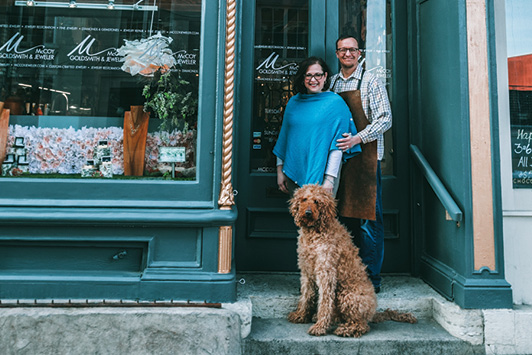
How’s business? The answer from most independent jewelers almost always includes a litany of concerns — diminishing margins, competition from online diamond sales, millennials who aren’t interested in buying diamonds. But Jonathan McCoy, owner of McCoy Jeweler in Dubuque, Iowa, reports strong sales and higher profit margins. His response to the issues plaguing the industry: successfully introducing lab-grown diamonds into the mix in 2014.
Seeking a technology solution came naturally to McCoy, who acknowledges that he joined the business “in reverse order.” His father, Robert McCoy, opened McCoy Jeweler in 1973, but Jonathan pursued a career in Silicon Valley as a developer and technology consultant. When a new job failed to materialize, he returned to assist his father, who had recently introduced Matrix and CAD operations. Eventually, he joined the business full-time.
“We couldn’t survive, with margins barely above wholesale, or customers coming in with diamonds purchased on the internet and asking that we only provide the mounting,” McCoy explains. “When looking at our options, I was blown away by the quality and price of the lab-grown.”
Four years ago, the selection of sizes and cuts was very limited, he notes. However, “we focused on high-quality rounds. Within six months, every single one was sold.” Lab-grown now accounts for over 80% of his diamond sales, excluding diamond fashion jewelry.
Letting the customer decide
McCoy emphasizes that mined and lab-grown diamonds are put on the same playing field in presentations to the consumer. “We show lab-grown as an option — not as a lesser choice, but as an alternative choice. Price is such an enormous factor. A customer would come in with a $5,000 budget, thinking she would get a 0.75-carat center stone and leaving thrilled that she can show off a 1.50-carat center stone. And it’s often the future bride who convinces her fiancé to buy a larger stone.”
Jewelers benefit as well, given the higher margins on lab-grown diamonds.
McCoy observes that there has been “zero pushback” among customers when given the option of a lab-created diamond, especially since they are now available in the popular cuts and shapes: rounds, ovals and cushions. In response to customer demand, the number of lab-grown manufacturers has increased, providing McCoy the opportunity to fine-tune his selection. McCoy points to a “really good system in place”: working with a primary supplier and, when needed, a specialty manufacturer.
Millennials do buy
More importantly, lab-grown has become a “dominating force” across all demographics.
“We sell to millennials all day long with no issues,” says McCoy. “Our social, online and philanthropic advertising resonates locally, and they seek us out. But the…55- to 75-year-old demographic is jumping on board as well. At this very moment, there is a woman who lost her 5-carat ring at the country club and is going to come in and replace it with a lab-grown diamond.”
McCoy has also seen an evolution in another facet of his business — custom design with mined diamonds.
“We couldn’t do enough designs to meet the customers coming through the door, and needed to keep that dynamic going,” he says. To complete that piece of the puzzle, he introduced diamond designers/manufacturers Noam Carver and CrownRing, who can create to his custom specifications. Both companies are exclusive to McCoy in the area.
“For some reason, independents have not incorporated lab-grown as a viable option for bridal sales,” McCoy says. “It was really key for us for continued growth without raising prices or lowering margins. We are even more competitive now, and our profits are continuing to rise.”
Image: Jonathan McCoy, owner, lead designer and bench, with Jennifer McCoy - owner and sales and diamond manager - and Troy the dog.Article from the Rapaport Magazine - September 2018. To subscribe click here.